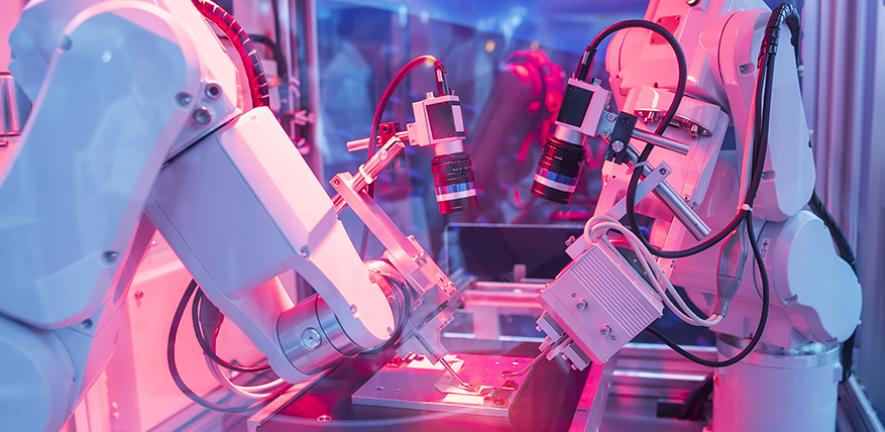
Researchers have found that robots can have a ‘U-shaped’ effect on profits: causing profit margins to fall at first, before eventually rising again.
Researchers have found that robots can have a ‘U-shaped’ effect on profits: causing profit margins to fall at first, before eventually rising again.
It’s important that companies develop new processes at the same time as they’re incorporating robots, otherwise they will reach this same pinch point
Chander Velu
The researchers, from the University of Cambridge, studied industry data from the UK and 24 other European countries between 1995 and 2017, and found that at low levels of adoption, robots have a negative effect on profit margins. But at higher levels of adoption, robots can help increase profits.
According to the researchers, this U-shaped phenomenon is due to the relationship between reducing costs, developing new processes and innovating new products. While many companies first adopt robotic technologies to decrease costs, this ‘process innovation’ can be easily copied by competitors, so at low levels of robot adoption, companies are focused on their competitors rather than on developing new products. However, as levels of adoption increase and robots are fully integrated into a company’s processes, the technologies can be used to increase revenue by innovating new products.
In other words, firms using robots are likely to focus initially on streamlining their processes before shifting their emphasis to product innovation, which gives them greater market power via the ability to differentiate from their competitors. The results are reported in the journal IEEE Transactions on Engineering Management.
Robots have been widely used in industry since the 1980s, especially in sectors where they can carry out physically demanding, repetitive tasks, such as automotive assembly. In the decades since, the rate of robot adoption has increased dramatically and consistently worldwide, and the development of precise, electrically controlled robots makes them particularly useful for high-value manufacturing applications requiring greater precision, such as electronics.
While robots have been shown to reliably raise labour productivity at an industry or country level, what has been less studied is how robots affect profit margins at a similar macro scale.
“If you look at how the introduction of computers affected productivity, you actually see a slowdown in productivity growth in the 1970s and early 1980s, before productivity starts to rise again, which it did until the financial crisis of 2008,” said co-author Professor Chander Velu from Cambridge’s Institute for Manufacturing. “It’s interesting that a tool meant to increase productivity had the opposite effect, at least at first. We wanted to know whether there is a similar pattern with robotics.”
“We wanted to know whether companies were using robots to improve processes within the firm, rather than improve the whole business model,” said co-author Dr Philip Chen. “Profit margin can be a useful way to analyse this.”
The researchers examined industry-level data for 25 EU countries (including the UK, which was a member at the time) between 1995 and 2017. While the data did not drill down to the level of individual companies, the researchers were able to look at whole sectors, primarily in manufacturing where robots are commonly used.
The researchers then obtained robotics data from the International Federation of Robotics (IFR) database. By comparing the two sets of data, they were able to analyse the effect of robotics on profit margins at a country level.
“Intuitively, we thought that more robotic technologies would lead to higher profit margins, but the fact that we see this U-shaped curve instead was surprising,” said Chen.
“Initially, firms are adopting robots to create a competitive advantage by lowering costs,” said Velu. “But process innovation is cheap to copy, and competitors will also adopt robots if it helps them make their products more cheaply. This then starts to squeeze margins and reduce profit margin.”
The researchers then carried out a series of interviews with an American medical equipment manufacturer to study their experiences with robot adoption.
“We found that it’s not easy to adopt robotics into a business – it costs a lot of money to streamline and automate processes,” said Chen.
“When you start bringing more and more robots into your process, eventually you reach a point where your whole process needs to be redesigned from the bottom up,” said Velu. “It’s important that companies develop new processes at the same time as they’re incorporating robots, otherwise they will reach this same pinch point.”
The researchers say that if companies want to reach the profitable side of the U-shaped curve more quickly, it’s important that the business model is adapted concurrently with robot adoption. Only after robots are fully integrated into the business model can companies fully use the power of robotics to develop new products, driving profits.
A related piece of work being led by the Institute for Manufacturing is a community programme to help small- and medium-sized enterprises (SMEEs) to adopt digital technologies including robotics in a low-cost, low-risk way. “Incremental and step changes in this area enable SMEs to get the benefits of cost reduction as well as margin improvements from new products,” said co-author Professor Duncan McFarlane.
The research was supported by the Engineering and Physical Sciences Research Council (EPSRC) and the Economic and Social Research Council (ESRC), which are both part of UK Research and Innovation (UKRI). Chander Velu is a Fellow of Selwyn College, Cambridge. Duncan McFarlane is a Fellow of St John's College, Cambridge.
Reference:
Yifeng P Chen, Chander Velu, Duncan McFarlane. ‘The Effect of Robot Adoption on Profit Margins.’ IEEE Transactions on Engineering Management (2023). DOI: 10.1109/TEM.2023.3260734

The text in this work is licensed under a Creative Commons Attribution-NonCommercial-ShareAlike 4.0 International License. Images, including our videos, are Copyright ©University of Cambridge and licensors/contributors as identified. All rights reserved. We make our image and video content available in a number of ways – as here, on our main website under its Terms and conditions, and on a range of channels including social media that permit your use and sharing of our content under their respective Terms.




